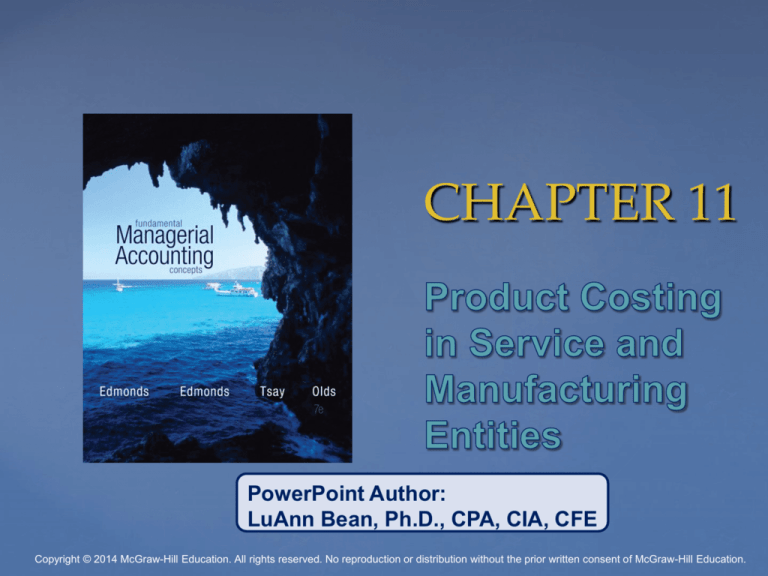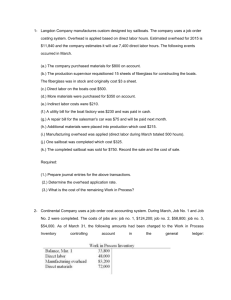
CHAPTER 11
PowerPoint Author:
LuAnn Bean, Ph.D., CPA, CIA, CFE
Copyright © 2014 McGraw-Hill Education. All rights reserved. No reproduction or distribution without the prior written consent of McGraw-Hill Education.
Cost Flow in Manufacturing
Companies
Income
Raw
Materials
Cost of
Materials
Available
for Use
Balance Sheet
Work-inProcess
Finished
Goods
• Materials
Used
• Labor
• Overhead
Total Mfg.
Costs
Incurred
Ending
Inventory
Statement
Ending
Inventory
Cost of
Goods Mfd.
Cost of
Goods
Sold
Ending
Inventory
11-2
Cost Flow in Service
Companies
Service companies do not have
work-in-process and finished
goods inventory accounts
where costs are stored before
being transferred to a cost of
goods sold account.
11-3
Manufacturing Cost Flow
Direct
Labor
Direct
Material
Manufacturing
Overhead
The
Product
11-4
Manufacturing Overhead
All other manufacturing costs
Indirect
Material
Materials used to support the production
process. Examples: Lubricants and cleaning
supplies used in an automobile assembly plant.
Indirect
Labor
Cost of personnel who do not work directly on
the product. Examples: Maintenance workers,
janitors and security guards.
Other
Costs
Examples: Depreciation on plant and
equipment, property taxes, insurance, utilities,
overtime premium, and unavoidable idle time.
11-5
Manufacturing Cost Flow
Wages Payable
•Direct
Labor
•Indirect
Labor
Mfg. Overhead
•Indirect •Overhead
Material Applied to
Work in
•Indirect
Process
Labor
Work-in-Process
•Direct
Material
•Direct
Labor
•Overhead
Applied
If actual and applied
manufacturing overhead are
not equal, a year-end
adjustment is required.
11-6
Manufacturing Cost Flow
Work-in-Process
•Direct
•Cost of
Material
Goods
Mfd.
•Direct
Labor
•Overhead
Applied
Finished Goods
•Cost of
Goods
Mfd.
•Cost of
Goods
Sold
Cost of Goods Sold
•Cost of
Goods
Sold
11-7
Flow of Overhead Costs
Using a predetermined rate makes it
possible to estimate total job costs sooner.
$
Actual overhead for the period is not
known until the end of the period.
11-8
Flow of Overhead Costs
A predetermined overhead rate (POHR), used to apply
overhead to products, is determined before the period begins.
POHR =
POHR =
Estimated total manufacturing
overhead cost for the period
Estimated total units in the
allocation base for the period
$40,320
12,000 jewelry boxes
=
$3.36
per box
11-9
Flow of Overhead Costs
Based on estimates,
and determined
before the period
begins.
Overhead applied = POHR × Actual activity
Actual amount of the
allocation base such as
units produced, direct labor
hours, or machine hours.
11-10
Analyzing Underapplied
Overhead
Actual
Overhead
Incurred
Overhead
Budget
Overhead
Applied
$43,400
$40,320
$39,648
Spending variance
$3,080 unfavorable
Volume variance
$672 unfavorable
Total variance is $3,752 unfavorable, the
amount of underapplied overhead.
11-11
Schedule of Cost of Goods
Manufactured and Sold
Ventra Manufacturing Company
Schedule of Cost of Goods Manufactured and Sold
Direct Raw Material Used
$
25,960
Direct Labor
33,040
Actual Manufacturing Overhead
43,400
Total Manufacturing Costs
102,400
Plus Beginning Work-in-Process Inventory
0
Total Work-in-Process Inventory
102,400
Less Ending Work-in-Process Inventory
8,360
Cost of Goods Manufactured
94,040
Plus Beginning Finished Goods Inventory
836
Cost of Goods Available for Sale
94,876
Less Ending Finished Goods Inventory
Cost of Goods Sold
7,524
87,352
$
11-12
Motive to Overproduce
Absorption Costing
Hokai Company incurs the following
costs to produce 2,000 units of inventory:
Let’s see what happens to costs
if Hokai increases production.
11-13
Motive to Overproduce
Absorption Costing
Now let’s compute income at the three levels
of production if Hokai sells 2,000 units.
11-14
Motive to Overproduce
Absorption Costing
Level of Production
Sales @ $20 per unit × 2,000 units
Cost of Goods Sold
$15 per unit × 2,000 units
$13 per unit × 2,000 units
$12 per unit × 2,000 units
Gross Margin
2,000
$ 40,000
3,000
$ 40,000
4,000
$ 40,000
30,000
26,000
$ 10,000
$ 14,000
24,000
$ 16,000
Internally, many companies use variable costing
to motivate managers to increase profitability
without motivating them to overproduce.
11-15
Variable Costing
Net income is not affected by production increases.
11-16
End of Chapter 11
11-17






